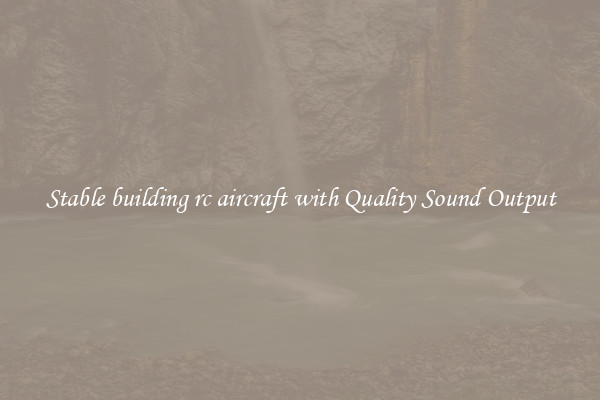Stable building rc aircraft with Quality Sound Output
Building RC aircraft is a popular hobby that brings joy and excitement to enthusiasts worldwide. While the focus is often on the visual appeal of these miniature aircraft, there is another element that shouldn't be overlooked – the sound output. A quality sound output can make the flying experience even more immersive and enjoyable. In this article, we will explore the importance of stable building in RC aircraft and how it can enhance the sound quality.

When it comes to flying RC aircraft, stability is of utmost importance. A stable aircraft ensures smooth and controlled flights, allowing pilots to perform maneuvers confidently. A well-built aircraft eliminates unwanted vibrations and wobbling, which can negatively impact the sound output. By ensuring stability, the sound produced by the aircraft can be cleaner and more defined.
To achieve stability, careful attention must be paid to the construction of the RC aircraft. Structural integrity is crucial, and all components must be securely attached and balanced. Any loose or flimsy parts can result in vibrations, leading to distorted sound output. It is recommended to use high-quality materials that are known for their durability and rigidity.
In addition to stability, the design of the airplane can also affect the sound output. The shape and geometry of the aircraft impact the way sound waves travel and interact with the surroundings. Design modifications, such as adding baffles or sound chambers, can alter the sound characteristics and improve the overall audio experience. Experimenting with different designs and materials can help optimize the sound output and create a unique audio signature.
Furthermore, the choice of propulsion system can significantly impact the sound produced by the RC aircraft. Electric motors, internal combustion engines, or even jet turbines each produce distinctive sound profiles. Some enthusiasts prefer the whirring sound of electric motors, while others enjoy the traditional hum of an internal combustion engine. Regardless of the preferred sound, it is important to ensure that the propulsion system is properly installed and maintained for optimal performance.
To further enhance the sound quality, sound systems can be integrated into RC aircraft. Miniature speakers can be installed to reproduce realistic engine sounds, adding an extra layer of excitement to the flying experience. These sound systems can be programmed to match the RPM of the motors, providing an immersive audio experience that mimics actual aircraft engines.
In conclusion, stable building in RC aircraft is not only crucial for flight performance but also for sound quality. A well-built and stable aircraft eliminates vibrations and unwanted noise, resulting in cleaner and more defined sound output. By optimizing the design, choosing the right propulsion system, and utilizing sound systems, enthusiasts can enjoy an immersive flying experience with high-quality sound. So next time you work on building your RC aircraft, don't forget to pay attention to stability and sound, creating an unforgettable experience in the sky.

View details

View details

View details

View details








